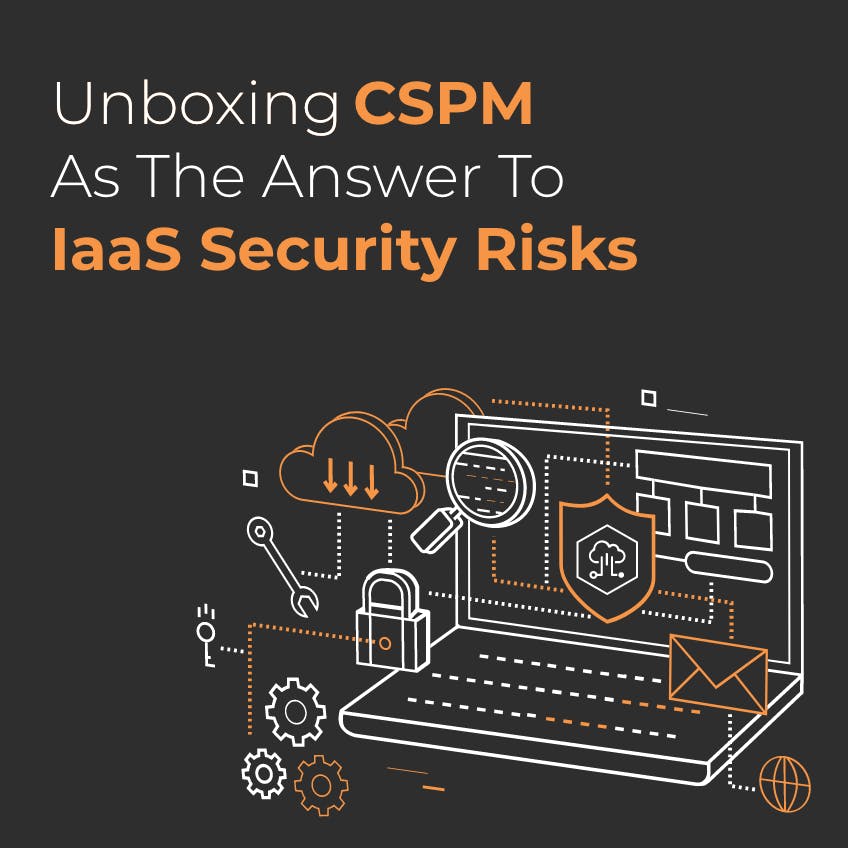With more organizations migrating to the cloudmore organizations migrating to the cloud, the risks stemming from misconfiguration and rapid scaling increases along with it. From lack of controls and misconfiguration to cloud sprawl, there are a number of cybersecurity risks facing organizations in the cloudcybersecurity risks facing organizations in the cloud. Cloud Security Posture Management (CSPM) solutions can ensure security in a landscape getting more dependent on cloud infrastructure. And in 2021, it was revealed by Gartner that CSPMs have become mandatory toolsGartner that CSPMs have become mandatory tools for organizations in the cloud.
We first look at the security risks that originate from Infrastructure-as-a-Service (IaaS) usage:
Major IaaS Security Risks
Emphasis on rapid scaling and deployment
Cloud Service Providers (CSP) make it easy for organizations to deploy resources globally. This not only makes for more complex cloud architecture but also more complex data management as different countries have different regulations governing data storage.
In the age of Infrastructure as Code, organizations can easily deploy an entire stack with just a few lines of codeorganizations can easily deploy an entire stack with just a few lines of code. What makes companies more agile also makes it easier for them to introduce resources without the proper controls.
In on-premise infrastructure, a dedicated infrastructure team deploys changes application developers request. After which, the security team then audits these changes and ensures that they adhere to best practices. With the move to the cloud, application teams can deploy these changes themselves. For teams that focus on shipping as quickly as possible without a strict review process, it is easy for developers to misconfigure cloud resources and leave them vulnerable to attackers.
Misconfiguration
One Amazon Web Services (AWS) S3 bucket exposed to the public internet can lead to the accidental exposure of critical data in your cloud to unauthorized and malicious actorsexposure of critical data in your cloud to unauthorized and malicious actors. In fact, Gartner estimates that as much as 99% of cloud security failures will be the customer’s fault.
Misconfigurations can happen due to a variety of reasons:
- Fundamental differences between cloud and on-premise security: Cloud securityCloud security requires a different approach compared to traditional on-premise environments. For example, unlike typical user accounts in an on-premise setting, user accounts in a cloud environment have a wider range of permissions to take advantage of unless the organization enforces resource access controls.
- Rapid pace of technology changes: AWS provides over 160 services (and counting), each with its own different security model. The more cloud services an organization uses, the higher the risk of not understanding the security model and misconfiguring resources of that service.
Confusion on Shared Responsibility
Unlike on-premise infrastructure where the organization is responsible for security end-to-end, cloud security works on the concept of shared responsibility between the CSP and the customershared responsibility between the CSP and the customer.
Under the shared responsibility model, the CSP is responsible for the security ‘of the cloud’. This covers the physical, software, and network security of the assets that the CSP needs to deliver its services.
On the other hand, the organization is responsible for security ‘in the cloud’. Among these responsibilities include configuring various cloud services with security best practices in mind and managing access to the data the organization stores in the cloud.
Cloud sprawl
Cloud sprawl happens when an organization creates more cloud resources than they need without any means to monitor and manage all these resources. This can not only introduce unnecessary costs, but also introduce added security risks since a lot of organizations do not have a means of monitoring all these resources in place.
Non-security experts making decisions
Gone are the days that all security decisions fall under the purview of the security team. Some of the security decisions that non-security experts end up deciding on include:
- Managing access control to the cloud management plane
- Securing access to resources of various services
- Usage of encryption in the application architecture within the cloud infrastructure
Because of the need to ship rapidly, traditional security applications and the people that operate them need to keep up with the pace, otherwise they risk leaving vulnerabilities undetected for long periods of time.
Security is everyone’s responsibility. In order for people with little to no background on cloud security to make sound decisions, there needs to be a way to gather and analyze cloud infrastructure data. With this data, teams then can understand what action items should be prioritized and which risks they can accept.
What CSPMs Do
Gartner defines Cloud Security Posture Management (CSPM) as an application that continuously monitors cloud misconfigurations in relation to security and compliance risks. Specifically, a CSPM solution could help your organization:
- Continuously monitor cloud configuration changes
- Mitigate security risks in your cloud infrastructure like exposed security groups or overly permissive access policies
- Assist you in remediating these misconfigurations
Who Should Use CSPMs
While a CSPM solution is recommended for all organizations, there are certain organizations that especially benefit from having one:
Organizations who manage large or critical cloud workloads
The larger and more complex your cloud infrastructure, the more attractive a target is for malicious actors. Cloud misconfigurations not only leave your data vulnerable to unauthorized parties but also create exorbitant costs in the form of penalties or fraudulent chargesexorbitant costs in the form of penalties or fraudulent charges.
Organizations with multiple cloud service accounts
Managing just one cloud account is difficult enough as it is, let alone having multiple accounts with a single CSP. A CSPM collates all these data and presents them in a more accessible form so you’ll have a big picture of your cloud security posture.
Organizations in highly regulated industries
Certain industries like the financial and health sectors face the need to comply with many regulations due to the nature of their business. The cost of non-compliance can be steepcost of non-compliance can be steep so a CSPM can help an organization in their need to comply with laws and regulations that apply to them.
CSPM Benefits
With IaaS security risks in mind, how does a CSPM counter those risks?
Greater visibility of cloud infrastructure
A CSPM scans your cloud service account for all the services it supports and gives you a view of all the information and risks you need to know about a resource or service.
Continuous cloud security risk assessment
CSPMs continuously monitor your cloud infrastructure for common misconfigurations, show you all the issues it finds, and tell you how to fix them.
Support for compliance standards and cybersecuritycybersecurity frameworks
CSPMs come supported with frameworks such as ISO 27001 and CISsupported with frameworks such as ISO 27001 and CIS. For organizations that need to be continuously compliant with these standards, CSPMs can immediately determine where you stand in your compliance posture and where your gaps are.
Check out Horangi WardenHorangi Warden, a CSPM solution for organizations using AWS or GCP IaaS. 14-day trial14-day trial available.




